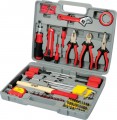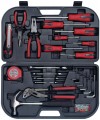Total number of items
The total number of core items included in the set.
In this case, the main items are all devices that are directly used during work: non-separable tools (traditional wrenches, hammers, pliers ...), elements of collapsible tools (for example, a ratchet for removable heads and 5 such heads will be considered 6 units) , as well as accessories (such as extensions or universal joints). Additional accessories — such as lights — may or may not be included in this count, depending on the manufacturer; however, there are usually few such accessories, and they do not fundamentally affect the total number of items.
The most modest modern tool kits include
up to 25 units. However, such kits are very popular — they are inexpensive and at the same time can be very versatile.
25 – 50 items is still quite a small number,
50 – 75 pcs can be called an average,
76 – 100 items are more than average, and the most extensive modern sets can include
100 – 150 items or even
more.
The general rules for choosing this parameter are obvious: a more extensive set, usually, is more multifunctional, but more expensive, weighs more and takes up more space. It is also worth bearing in mind that with a similar number of items, the specific assortment of these items in differ
...ent sets may be different; so when choosing, it is worth specifying not only the number of tools, but also their specific composition.Socket heads (6 points)
Number of
hex sockets included in the tool kit.
All end heads are accessories for a collapsible tool; during operation, they are mounted on a ratchet, wrench or other similar device. The head itself has the appearance of a characteristic “cap”, which, during operation, is put on a bolt, nut, etc. This design, among other things, allows you to work with parts located in recesses and some other hard-to-reach places that cannot be reached with open-ended, captive or split keys. And compared to a set of classic socket wrenches, the holder plus socket set takes up much less space, providing almost the same functionality.
As for the 6 faces, this type of socket head is the most famous and widespread, because. most modern nuts and bolts have this shape.
Socket heads sizes (6 points)
Working size range of hex sockets (see above) supplied with the kit. This parameter allows you to evaluate how the heads fit the dimensions of the fasteners with which they are planned to be used.
Bits
The number of
bits supplied with the tool kit.
A bat in this case is called a working nozzle, which plays the role of a screwdriver tip; in fact, they are most often used with screwdriver handles (see above).
Many types of splines (slots) are used in modern fasteners — starting with the well-known
straight, cross-shaped (
Phillips and
Pozidriv),
Torx sprockets and ending with exotics like Torq-set (a cross with lines shifted from the centre), Pentalobe (with five ledges), etc. .P. In addition, the size of the slots can also vary, and in many cases, tool matching in size is very important. Accordingly, the more bits supplied with the set, the more versatile it is, the higher the probability that it will contain a nozzle of the desired type and size. However, the specific list of bits in the kit also does not hurt to clarify — in order to make sure that it has all the varieties you need. In the characteristics of individual sets, these data are given in the paragraph "Bit sizes" (see below).
Adapter
An adapter for docking seemingly incompatible elements from a set. For example, socket heads with an unsuitable landing square on a ratchet, screwdriver handle or in a drill driver.
The adapter provides full-fledged work with all the required list of tools from the set.
Bit holder
Auxiliary bench tool that adapts the fit of the bit to the drill chuck. One end of the
bit holder is fixed in the chamber, the other — in the shank of the bit, which allows you to work with any type of equipment. It is used when performing work on screwing fasteners in spaces where it encounters certain difficulties. Many bit holders have the ability to magnetically hold fasteners.
Screwdriver handle
Number of
screwdriver handles supplied with the tool kit.
Such handles, in fact, are screwdrivers without a tip — in its place there is a seat for a bit. It can be either a square (see above) or a hexagon socket, often magnetic; in fact, the presence of more than one handle in the kit is typical mainly for cases where different types of fasteners are used. Also note that, in addition to fixed mounts, in which the bit is fixed rigidly, there are also reversible devices — with a ratchet mechanism, similar in operation to ratchets (see above).
Theoretically, bits can be used with other types of tools — for example, the ratchets described above — and in many sets this possibility is directly provided. At the same time, it is work in the format of a screwdriver that is considered the classic option, and often it is he who is optimal.
Open end wrenches
The number of open-
end wrenches supplied in the kit. Note that some modern kits
only include open-end wrenches, without any other fixtures or accessories.
Open-end wrenches are called classic wrenches with a U-shaped working profile. When working, they cover the part from three sides (on two — if the key clings to the very tips of the "horns"). Because of this, such wrenches lose to ring wrenches in terms of uniformity of impact and are less suitable for work in which significant efforts are required (horn tools are more likely to break off the part). However, in most cases this shortcoming is not critical. In addition, the U-shape of the profile allows you to work with pipelines, hoses, etc., on which it is impossible to put a spanner wrench, and also makes it possible to hold an open-end tool during operation similar to a screwdriver — not perpendicular to the axis of rotation of the fastener, but parallel. Due to this, in some cases, this type of key may well replace the end keys (see below).
Note that most often modern open-end wrenches are made double-sided, with working profiles of different sizes at different ends. As for the quantity, it is worth considering here: sets with the same number of keys of the same type may differ in the specific sizes of these tools. Such nuances should be clarified before buying separately.
Wrench sizes
Dimensions of the wrenches supplied in the set. Specified as a range — from the minimum to the maximum size. In this case, the specific distribution of different types of keys over the range may be different. An example is the following set: 17 open-end wrenches, 5 box wrenches, size range 6 – 24 mm. In such a set, box wrenches are almost guaranteed not to cover the entire range of sizes, but for open-end wrenches, this is quite likely. Such details can be specified separately.
Also note that a wrench size of
24mm or more is considered quite large for today's general purpose tools. However, on the market you can find sets that include wrenches for
27 mm,
30 mm and even
32 mm.

